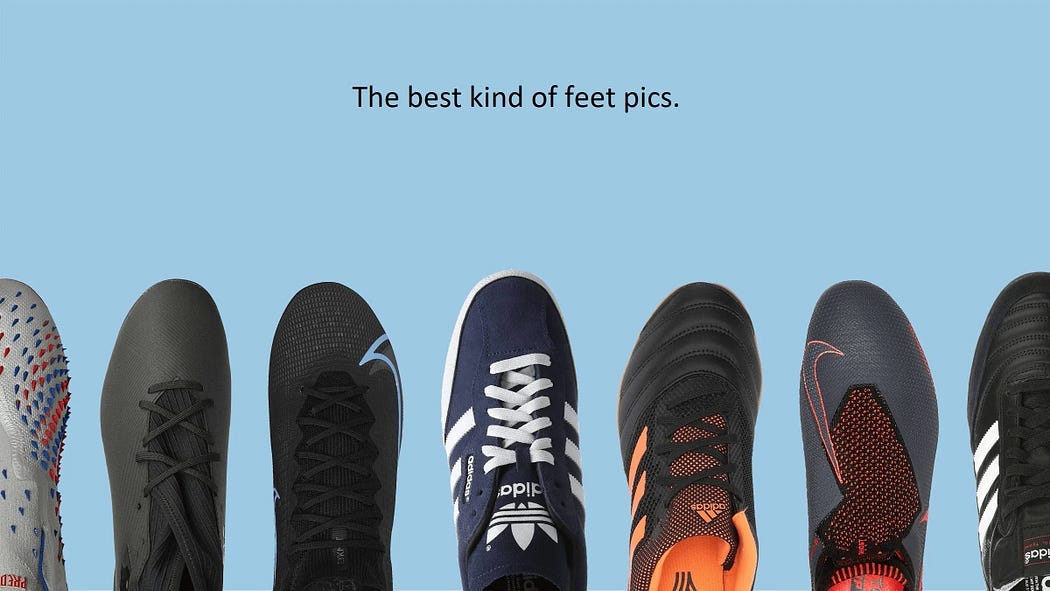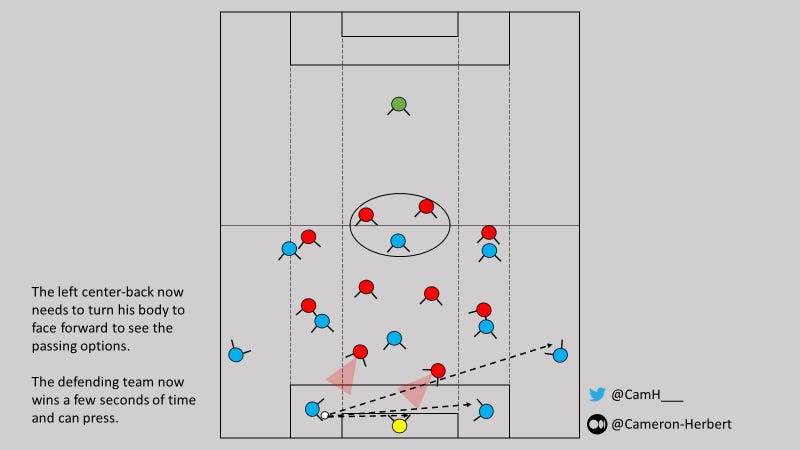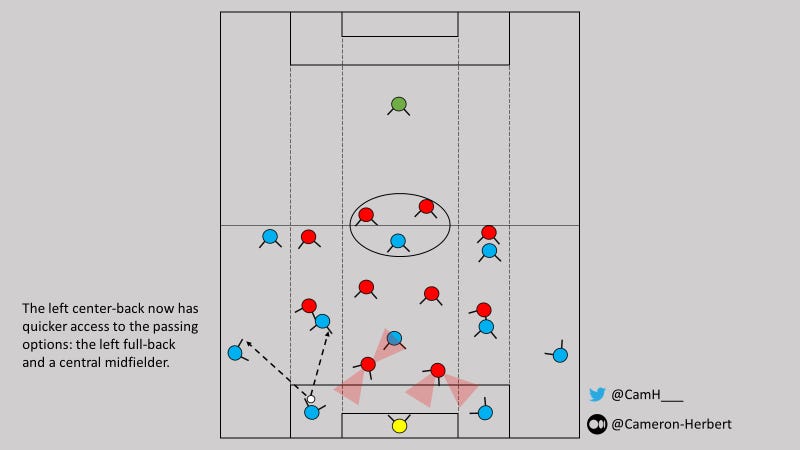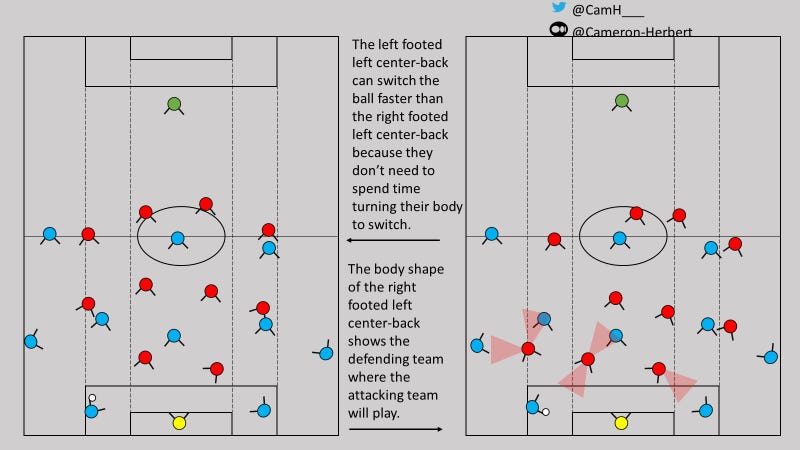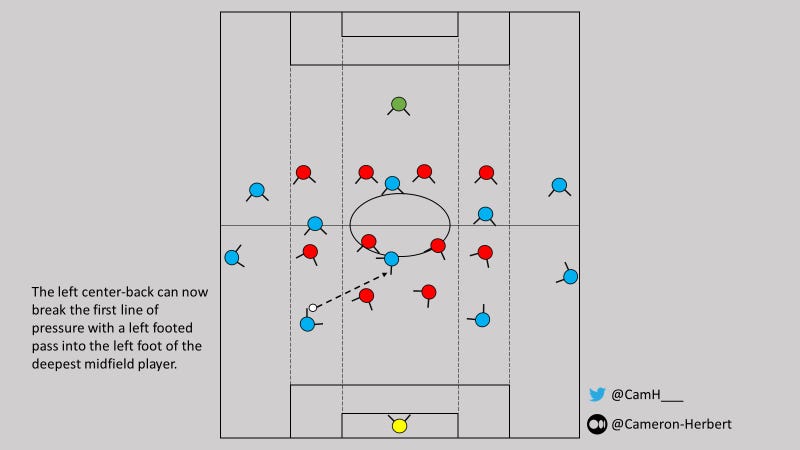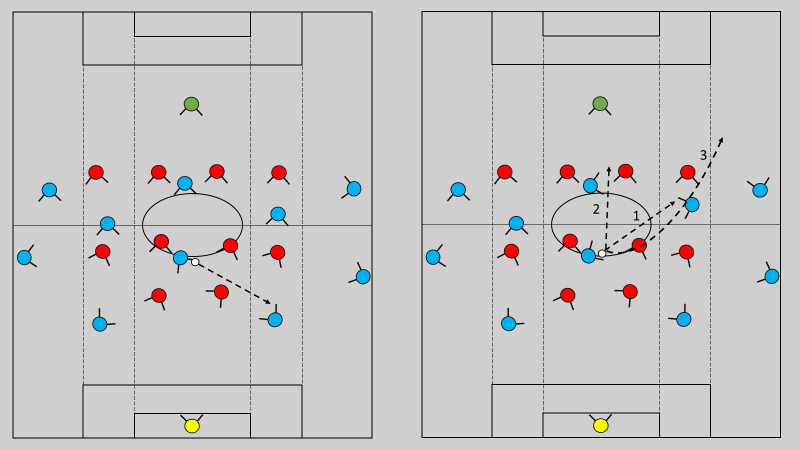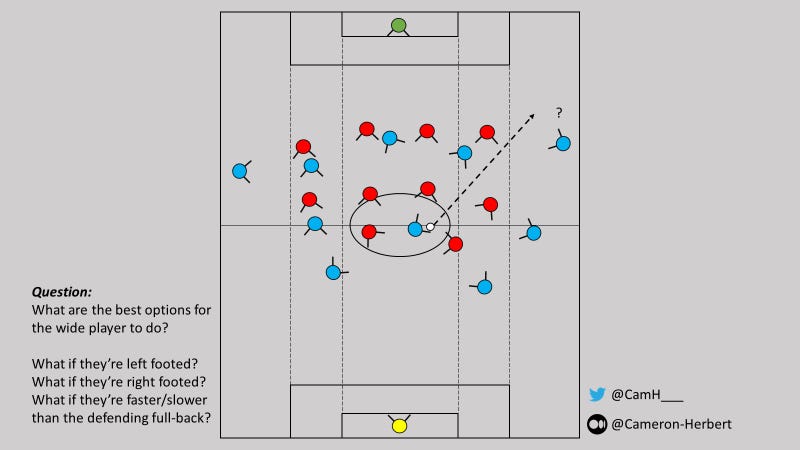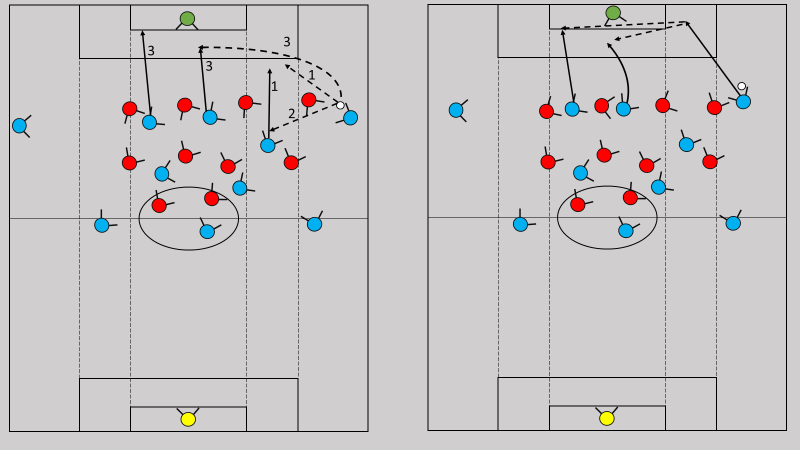Good morning! I want to talk about feet.
If you haven’t already, please subscribe!
Enjoy the newsletter!
The importance of footedness when receiving and playing a pass cannot be emphasized enough. Simply put: a player receiving the ball will decide how it’s passed or how they carry it.
There is a correct way to receive the ball so that it sets you up for the next action correctly. For example, receiving when a player is tightly marking you requires you to play a bounce pass backwards, setting up a “up-back-through.” However the same type of reception shouldn’t be done if you have space. The footedness matters when you have space to receive.
The first touch is vital for when the player receiving the ball uses the foot to set the ball for the next action, be it dribbling, passing or shooting. This set up helps determine how effective the next action will be.
Build up from goal
Playing a pass from the right center-back to the left foot of the left center-back is an easy enough decision that is unanimously understood as correct because it’s disadvantageous for the center-back to turn their whole body and receive the ball with their back to the touchline.
By receiving with your back to the touchline as a right-footed center-back, you’re opening yourself to pressure because your set touch is negative, going towards your own goal, or at best neutral. This set touch means that you now need to turn your body and the ball so that it faces the defending team in front of you, then make a decision to pass the ball.
This incorrect way of receiving the ball opens up the attacking team to unnecessary pressure. The only passing options are to send it back across goal to the goalkeeper or the center-back, or hit play a harder pass to the opposite full-back.
The correct way of receiving the ball that leads to the best set touch is to receive with your hips facing the defending team in front of you, slightly towards your own goal, and ready to receive with your left foot. Once you receive the ball you no longer need to waste a second or two turning your body to face the options in front of you — your body is already open.
New problem: Can the left center-back switch the ball to the right side after they attract pressure?
If the left-center back is naturally left footed then it should be a simple clipped aerial ball to the opposite full-back. If the center-back is right footed they need to turn their body again to face the way they want to play the pass more than the left footed passer in order to get the ball on their strong foot.
The problem is that the right footed left center-back takes more time to get the ball to the right side of the pitch than the left footed center-back because they spend one second turning their body. This turn of the body can be a pressing trigger for the defending team to mark attacking players on the right side of the pitch while using their forwards to force a pass. The left footed center-back can play the pass a second sooner — not giving the defending team the obvious pressing trigger option.
Middle third and final third
The opportunity to lose the ball due to poor footedness increases when we enter the middle third. By passing to the incorrect foot of the recipient or taking an extra second to switch to our strong foot before playing the pass, we lose time and potentially the ball.
By analyzing the above, we can see that the left center-back has space to pass to the deepest midfield player. The correct way to play this pass is to use the left center-backs left foot and pass to the deepest midfielders left foot.
We pass to the left foot from this angle for two reasons. First, the left foot allows the recipient to receive away from the pressure from the other team. It’s a tight space, but there’s more space on the midfielders left than the right. The second reason is that the recipient has better passing options.
The most obvious is the right center-back, to be used when the midfielder comes under too much pressure to continue.
The better options come if the recipient is able to turn a few degrees more, facing forward. This gives the player sight of the closest half-space player, the center-forward and one of the wide players.
All of these options become very accessible if the recipient is able to receive on their left foot, on the half-turn and set the ball correctly for the next action.
Footedness with wingers and their ability to break the lines is as important as our midfield options. Refer picture below.
What type of touch does the player take?
Where does the touch take the ball?
How should our winger take their touch if they’re faster than the defending full-back? What if they’re slower?
Left pitch:
The wide option who is right footed seemingly has more available options because these options favor right footed players. Inside passes to an underlapping half-space player or a through pass to the same player running through the space between the center-back and full-back are easy and fast because they require less movement from the passer.
More direct options include playing a cross to the penalty spot or far post.
All of these options are very difficult if the player is heavily one footed. A left footed wide player on the right may only be able to play an underlapping pass but not the direct one. The left footed player may only be able to use their flair and skill to beat their defender one versus one.
A left footed player may be effective at creating chances, but their options are limited and they’ll need to be great at executing their limited options.
Right pitch:
This pitch shows an option that is nearly exclusive to right footed right sided wide players. This asks them to drive to goal into the half-space themselves. This gives the player the cutback option or the option to take a near post shot at goal.
The natural stride of a right footed player in this situation favors the attacking team. A pass hit with power and speed to this wide player can be controlled easier by a right footed player. This touch can set up the next action much easier than if the player were left footed. So, when the attacker hits their stride they don’t need to waste time orienting their body onto their strong foot.
Their attacking options are already available to them to execute as soon as they want to.
How can coaches use this?
A lot of what is posted online about football tactics and theory largely covers what to do/happened in possession.
Footedness is great for the passing and receiving angles it gives players. It can also be the downfall of a team trying to keep the ball.
See the first example again. Poor footedness will lead to an obvious pressing trigger or target. The player themselves is a trigger but there’s more that can be done.
Idea:
Delay the opponent during your high press and force the switch to the weak player (or a long ball, but this is likely not in line with several game models these days, so the switch is more common.)
Once the ball arrives at the weakest player don’t press them. Instead, have the furthest defender curve their run and encourage the weakest player to carry the ball. The further they carry the ball the more dangerous it is for their team because they’ve allowed a defender to leave their position.
At the highest level, like the Premier League in England, this isn’t a feasible idea. Seeing as none of the people reading this will ever coach at that level, feel free to keep this idea for yourself,
Forced Switch Session Plan:
https://twitter.com/CamH___/status/1628774480788037635?s=20
Epilogue
What started as a tangent I went on when driving with Marc to Chipiku has turned into an idea I couldn’t stop thinking about.
Marc is unbelievably patient. If you’re reading this, thanks for letting me ramble pal.
Some Marc quotes I liked after he read the initial draft of this piece.
“As a coach I would use it more to think about it from a defensive viewpoint. How do I set up to press a right footed, left CB. How do I defend inverted wingers… “
“My foot should never determine my first touch, it should always be determined by the opposition.”
Footedness as a conscious coaching point is something I wasn’t clear enough about before moving to Malawi. The players here aren’t two footed but they’re certainly more capable than most of the Canadian players I’ve worked with. The players here understand the value of footedness, conscious or not. The angle at which you receive the ball will help set up the next action.
I think if we look at it from that perspective we can be more conscientious about our coaching.
Thanks for reading this week! Please “like” this post by clicking the heart icon above. Substack will show this to more people if you like it, which means more paid members, which means more paid writers for this publication!
Once you’ve liked this, share this newsletter with a friend or every single person you have ever met.





